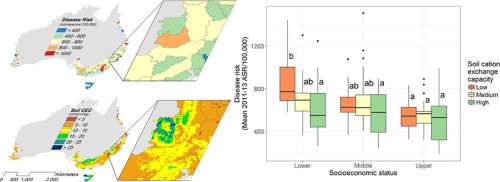Science of the Total Environment ( IF 8.2 ) Pub Date : 2018-01-12 , DOI: 10.1016/j.scitotenv.2018.01.077 Craig Liddicoat , Peng Bi , Michelle Waycott , John Glover , Martin Breed , Philip Weinstein

|
Human contact with soil may be important for building and maintaining normal healthy immune defence mechanisms, however this idea remains untested at the population-level. In this continent-wide, cross-sectional study we examine the possible public health benefit of ambient exposures to soil of high cation exchange capacity (CEC), a surrogate for potential immunomodulatory soil microbial diversity. We compare distributions of normalized mean 2011/12–2012/13 age-standardized public hospital admission rates (cumulative incidence) for infectious and parasitic diseases across regional Australia (representing an average of 29,516 patients/year in 228 local government areas), within tertiles of socioeconomic status and soil exposure. To test the significance of soil CEC, we use probabilistic individual-level environmental exposure data (with or without soil), and group-level variables, in robust non-parametric multilevel modelling to predict disease rates in unseen groups. Our results show that in socioeconomically-deprived areas with high CEC soils, rates of infectious and parasitic disease are significantly lower than areas with low CEC soils. Also, health inequality (relative risk) due to socioeconomic status is significantly lower in areas with high CEC soils compared to low CEC soils (Δ relative risk = 0.47; 95% CI: 0.13, 0.82). Including soil exposure when modelling rates of infectious and parasitic disease significantly improves prediction performance, explaining an additional 7.5% (Δ r2 = 0.075; 95% CI: 0.05, 0.10) of variation in disease risk, in local government areas that were not used for model building. Our findings suggest that exposure to high CEC soils (typically high soil biodiversity) associates with reduced risk of infectious and parasitic diseases, particularly in lower socioeconomic areas.
中文翻译:

澳大利亚区域环境土壤阳离子交换能力与传染病和寄生虫病风险成反比
人与土壤的接触对于建立和维持正常的健康免疫防御机制可能很重要,但是这种想法在人群水平上尚未得到检验。在这项跨大陆的横断面研究中,我们研究了环境暴露于高阳离子交换量(CEC)的土壤对公共健康的潜在好处,阳离子交换能力是潜在的免疫调节性土壤微生物多样性的替代物。我们比较了三分位数内澳大利亚地区(代表228个地方政府地区的平均29,516名患者/每年)的传染病和寄生虫病的标准化平均2011 / 12–2012 / 13年龄标准化的公立医院入院率(累积发生率)的分布社会经济状况和土壤暴露状况。为了测试土壤CEC的重要性,我们在稳健的非参数多级建模中使用概率性的个人级别环境暴露数据(有或没有土壤)和组级别变量来预测未见人群的疾病发生率。我们的结果表明,在CEC含量高的社会经济匮乏地区,传染病和寄生虫病的发生率明显低于CEC含量低的地区。而且,与低CEC土壤相比,高CEC土壤地区由于社会经济状况引起的健康不平等(相对风险)要低得多(Δ相对风险= 0.47; 95%CI:0.13,0.82)。在对传染病和寄生虫病进行建模时,包括土壤暴露可显着改善预测性能,可解释为额外增加了7.5%(Δr 我们的结果表明,在CEC含量高的社会经济匮乏地区,传染病和寄生虫病的发生率明显低于CEC含量低的地区。而且,与低CEC土壤相比,高CEC土壤地区由于社会经济状况引起的健康不平等(相对风险)要低得多(Δ相对风险= 0.47; 95%CI:0.13,0.82)。在对传染病和寄生虫病进行建模时,包括土壤暴露可显着改善预测性能,可解释为额外增加了7.5%(Δr 我们的结果表明,在CEC含量高的社会经济匮乏地区,传染病和寄生虫病的发生率明显低于CEC含量低的地区。而且,与低CEC土壤相比,高CEC土壤地区由于社会经济状况引起的健康不平等(相对风险)要低得多(Δ相对风险= 0.47; 95%CI:0.13,0.82)。在对传染病和寄生虫病进行建模时,包括土壤暴露可显着改善预测性能,可解释为额外增加了7.5%(Δr 与低CEC土壤相比,高CEC土壤地区由于社会经济状况造成的健康不平等(相对风险)要低得多(Δ相对风险= 0.47; 95%CI:0.13,0.82)。在对传染病和寄生虫病进行建模时,包括土壤暴露可显着改善预测性能,可解释为额外增加了7.5%(Δr 与低CEC土壤相比,高CEC土壤地区由于社会经济状况造成的健康不平等(相对风险)要低得多(Δ相对风险= 0.47; 95%CI:0.13,0.82)。在对传染病和寄生虫病进行建模时,包括土壤暴露可显着改善预测性能,可解释为额外增加了7.5%(Δr2 = 0.075;在未用于模型构建的地方政府区域中,疾病风险差异的95%CI:0.05、0.10)。我们的发现表明,暴露于高CEC土壤(通常是较高的土壤生物多样性)会降低传染病和寄生虫病的风险,尤其是在较低的社会经济领域。











































 京公网安备 11010802027423号
京公网安备 11010802027423号